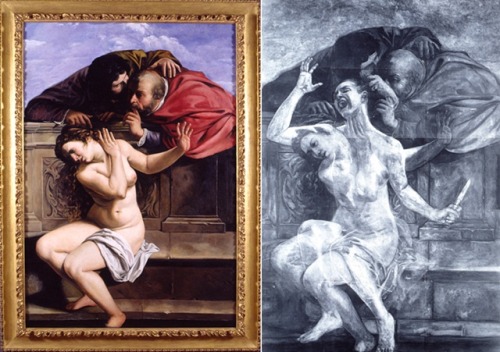Your gateway to endless inspiration
Art History - Blog Posts
I remember this one because it was in the syllabus for the EVAU, which is the exam that you have to take in Spain to enter college, and was one of the last chapters we had to study
as an art historian i usually assume people know more about art history than they usually do so i'm actually very curious


as always u can rb for bigger sample size but this is just curiosity for me :)

Hey chat, look what i found in my closet

Original designs (drawn in 2019)

Redesigns (drawn in 2025)










Bridal Asia Magazine - Shot by Anubhav Sood


Psyche Weeping, Kinuko Y. Craft I Ophelia, Friedrich Wilhelm Theodor Heyser


The Continuum of Beauty - Daniel Gerhartz
"The Kiss", a 12,000-year-old rock painting at Pedra Furada in Brazil


Susanna and the Elders, Restored (Left)
Susanna and the Elders, Restored with X-ray (Right)
Kathleen Gilje, 1998







Jackie Ormes, the first Black American woman cartoonist
When the 14-year-old Black American boy Emmett Till was lynched in 1955, one cartoonist responded in a single-panel comic. It showed one Black girl telling another: “I don’t want to seem touchy on the subject… but that new little white tea-kettle just whistled at me!”
It may not seem radical today, but penning such a political cartoon was a bold and brave statement for its time — especially for the artist who was behind it. This cartoon was drawn by Jackie Ormes, the first syndicated Black American woman cartoonist to be published in a newspaper. Ormes, who grew up in Pittsburgh, got her first break as cartoonist as a teenager. She started working for the Pittsburgh Courier as a sports reporter, then editor, then cartoonist who penned her first comic, Torchy Brown in Dixie to Harlem, in 1937. It followed a Mississippi teen who becomes a famous singer at the famed Harlem jazz club, The Cotton Club.
In 1942, Ormes moved to Chicago, where she drew her most popular cartoon, Patty-Jo ‘n’ Ginger, which followed two sisters who made sharp political commentary on Black American life.
In 1947, Ormes created the Patty-Jo doll, the first Black doll that wasn’t a mammy doll or a Topsy-Turvy doll. In production for a decade, it was a role model for young black girls. "The doll was a fashionable, beautiful character,“ says Daniel Schulman, who curated one of the dolls into a recent Chicago exhibition. “It had an extraordinary presence and power — they’re collected today and have important place in American doll-making in the U.S.”


In 1950, Ormes drew her final strip, Torchy in Heartbeats, which followed an independent, stylish black woman on the quest for love — who commented on racism in the South. “Torchy was adventurous, we never saw that with an Black American female figure,” says Beauchamp-Byrd. “And remember, this is the 1950s.“ Ormes was the first to portray black women as intellectual and socially-aware in a time when they were depicted in a derogatory way.
One common mistake that erased Ormes from history is mis-crediting Barbara Brandon-Croft as the first nationally syndicated Black American female cartoonist. “I’m just the first mainstream cartoonist, I’m not the first at all,” says Brandon-Croft, who published her cartoons in the Detroit Free Press in the 1990s. “So much of Black history has been ignored, it’s a reminder that Black history shouldn’t just be celebrated in February.”
Source
AI 'art' could never reignite someone's passion like Akira did for Kishimoto
AI 'art' could never create something as hauntingly visceral as Guernica
AI 'art' could never capture the tragedy of an artist nearing the end of their life the way Unfinished Painting did
AI 'art' is a joke
art is political.


Students of Mykhailo Boychuk Art Academy drawing their school that was hit by russian missile
The fujoshevik keeps commissioning socialist realist paintings of sweaty men in factories and cosmonauts holding each other tenderly









Female hands in paintings









A visual explanation of why stars fall on Earth. Details of The Augsburg Book of Miracles, an illuminated manuscript made in Augsburg in Germany in the 16th century, anonymous author-ess.